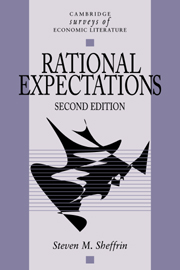Book contents
1 - The concept of rational expectations
Published online by Cambridge University Press: 05 June 2012
Summary
Two divergent schools of thought originated at Carnegie-Mellon University in the late fifties and early sixties. During this period Herbert A. Simon had been refining his ideas on “bounded” rationality, a doctrine stressing man's limited computational abilities in making decisions. At the same time, his colleague John F. Muth was working in another direction and developing the doctrine of rational expectations. Adding intrigue to this episode was the fact that Simon and Muth (along with Franco Modigliani and Charles Holt) were also collaborating on a book on inventory management and production control. Although the development of the diverse doctrines of bounded rationality and rational expectations by collaborators could be viewed as just a historical coincidence, it is more likely that an intense preoccupation with a common set of problems led the two researchers on different paths in search of a solution.
In their joint effort, Simon and Muth worked on problems of production scheduling and inventory management for the firm. These problems had been studied by many talented mathematicians, economists, and operations researchers who had developed general results for complex cases. The work of Holt, Modigliani, Muth, and Simon (1960) was aimed at deriving tractable, operational rules that could be easily applied in practice. As simplifying devices, they assumed that the various costs facing a company could be described by linear or quadratic cost functions.
- Type
- Chapter
- Information
- Rational Expectations , pp. 1 - 24Publisher: Cambridge University PressPrint publication year: 1996

